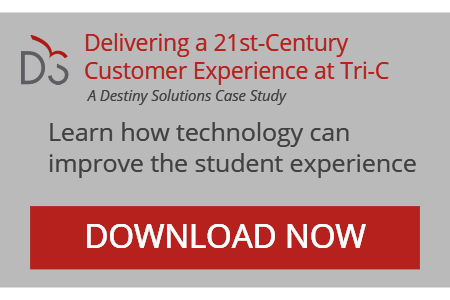Published on
Prioritizing Integration Critical to Finding the Right System that Facilitates Non-Credit Growth

Implementing a new back-end system for non-credit education is a serious undertaking for colleges and universities. The challenges compound when the non-credit system must integrate into a robust, well-established main campus system. In this interview, Bob Peterson discusses Tri-C Corporate College’s experience finding and implementing a new customer lifecycle management system to support college-wide non-credit program registrations and management while integrating tightly into the main campus’s Banner Enterprise Resource Planning (ERP) system.
The EvoLLLution (Evo): Why is non-credit programming so important to a community college?
Bob Peterson (RP): Community colleges have always had a particular emphasis on workforce training, whereas traditional four-year colleges have generally offered more theoretical programming and less applied hands-on training. Today, with the skills gap that exists in North America, employers are having a hard time finding qualified people with the right skills for the jobs they’re looking to fill.
What we’re emphasizing now more than ever is that Tri-C has non-credit workforce training programs that can provide employers in Northeastern Ohio with a skilled workforce—because at the end of the day, the success of our region is going to depend on whether we have a skilled workforce or not. If we don’t have a skilled workforce, employers are going to relocate, or they’re going to go out of business. Our community college, and I think all community colleges in the United States, understand that.
We actively engage with employers throughout the region so that we can understand what their specific training needs are. Then we look at our offerings and make sure that our current programs can meet those needs. If not, we modify them or create new programs so that employers’ needs are being met.
Evo: What were some of the key challenges that Tri-C was trying to address when you and your colleagues began searching for a new system for non-credit registration?
BP: One of the challenges we faced was making sure the needs of all of the various non-credit areas within the college were being met. Tri-C is a large community college with four academic campuses and four different workforce campuses, and our non-credit programming is decentralized. We have traditional non-credit workforce training. We have non-credit community education programs. We have Encore, which is a senior’s program for adults 55 and older. Our academic campuses offer some community programs—things like dancing or swim lessons or yoga classes—that are not part of workforce training, but are non-credit and need to use the registration system.
While the primary user of the new system was going to be our non-credit workforce training programs, we had all these other, smaller ancillary areas within the college that all needed to be able to use the system. We had to look at other diverse areas within the Tri-C and make sure that Destiny One met their needs too.
Evo: Why did Destiny One stand out to you as an ideal solution?
BP: One of the important specs that we had in the RFP we issued was the ability for the new system to communicate with our Banner ERP system. That was a particular advantage that Destiny One had over the competition: Destiny could communicate with Banner, and the competition could not.
The second important factor for us was Destiny’s experience with community colleges. Some of the other products on the market were being offered by vendors who were just breaking into the community college market with a newer offering, and we didn’t want to be a guinea pig. Destiny has a pretty wide and diverse college user group, and it’s growing. Being able to reach out and talk to other colleges like us was important. We could make sure that their experience with Destiny was good. We had our IT folks talk with IT folks at colleges that were also Banner ERP users, because that integration was very, very important to us. We were able to satisfy our due diligence questions by having phone calls directly with other colleges that had successfully implemented Destiny One.
Destiny One is also very user friendly, both from an internal and an external perspective. That combination of factors is why we reached the conclusion that Destiny One was the ideal solution.
Evo: Why is it so important for your non-credit system to integrate into and communicate with the main campus Banner ERP system?
BP: We’re a robust user of Banner, and we believe in the product. If Destiny One didn’t integrate with Banner, it would have effectively created a two-step process where student registration and financial information would not automatically migrate into Banner. It would have to be downloaded and then uploaded. With that, you always have the possibility for errors. It’s not as an efficient a process.
Because we rely upon Banner so heavily to operate and manage our college, that was a very, very important issue for us. Obviously, if none of the vendors were integrated with Banner, we would have had to pick our poison, so to speak, but the fact that Destiny One had a track record of successfully integrating with Banner, and we were able to verify that in the due diligence process, gave us a certain level of comfort.
Evo: What did it take to motivate staff to shift to new business processes? How do you expect the staff experience to change as Destiny One becomes an ingrained part of the way non-credit works?
BP: We needed to make sure people understood that we didn’t just decide to change our non-credit registration system on a whim. The product we had been using prior to Destiny One was no longer being supported by the vendor, so we shifted out of necessity—and a big part of the transition process involved making sure that people understood that. We didn’t want to be relying on a non-credit registration system that wasn’t being supported, especially as the possibility of it crashing and developing problems would exponentially increase once the support period expired.
The other big part of the process was making sure our team understood what Destiny had to offer. There are a lot of capabilities in the Destiny system that are very exciting and of great interest for our users. Once they saw that, and could see how it would enhance the student experience and grow enrollment while making their job easier, people started coming on board. It allowed us to change resistors into team players.
Evo: How do you expect the student experience to evolve for non-credit students at Tri-C with the Destiny One system in place?
BP: On our credit registration side, about 80 percent of our students register for classes online. With our old non-credit registration system, our online registrations were at about 20 percent. Our team would receive phone calls on a daily basis from non-credit students who were angry and exasperated because they weren’t able to successfully register online.
I’m responsible for workforce non-credit training enrollment numbers. If I have angry students, we have to talk them off the ledge, calm them down and then get them registered for a class. How many people don’t call and just walk away and go to another college to take a workforce training non-credit class? We can’t capture that data, but it was clear that we were losing students because people just got fed up.
We expect Destiny One to result in an increase in overall enrollment, but especially a surge in people who register online. Our goal is to move from 20 percent, which is horrible, to 80 percent, which is where it is on the credit side.
In less than six months, we’ve seen an increase in the number of students that are registering online using Destiny. In that time, our online registrations have grown 52 percent over the same period the previous year. That’s an early positive indicator.
Evo: How is the Destiny One shopping experience helping you meet the expectations of students who are trying to enroll in the non-credit offerings you have on deck?
BP: In the workforce non-credit training area, we serve a different type of student with different levels of expectation. The typical profile of our student is an adult with a four-year degree that’s employed in the workforce. They could be an employee of Sherwin-Williams or Progressive Insurance or KeyBank (one of Northeastern Ohio’s largest employers) who’s looking to upskill by taking a course with us.
We have more adults enrolling than on the credit side, and because they’re older and more sophisticated, they’re more demanding customers. I have a mid-level manager who wants to take a course with us on how to be a better supervisor. He can come to us or he can go to one of the several four-year colleges in Northeastern Ohio that offers similar courses. If I provide a negative user experience, he’ll walk away.
Evo: Is there anything you’d like to add about the impact that you see Destiny One having across the non-credit environment at Tri-C?
BP: We’ve only been live for less than six months, but the proof will ultimately be in the numbers. I imagine if we had this conversation in two years, I’d be able to show you that our enrollment has increased significantly above national averages because our system is more user friendly.
This interview was edited for length and clarity. To learn more about Tri-C’s implementation of the Destiny One Customer Lifecycle Management system, please click here.
Author Perspective: Administrator
Author Perspective: Community College



